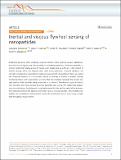Notice
This is not the latest version of this item. The latest version can be found at:https://dspace.mit.edu/handle/1721.1/136163.2
Inertial and viscous flywheel sensing of nanoparticles
Author(s)
Katsikis, Georgios; Collis, Jesse F; Knudsen, Scott M; Agache, Vincent; Sader, John E; Manalis, Scott R; ... Show more Show less
DownloadPublished version (1.778Mb)
Publisher with Creative Commons License
Publisher with Creative Commons License
Creative Commons Attribution
Terms of use
Metadata
Show full item recordAbstract
<jats:title>Abstract</jats:title><jats:p>Rotational dynamics often challenge physical intuition while enabling unique realizations, from the rotor of a gyroscope that maintains its orientation regardless of the outer gimbals, to a tennis racket that rotates around its handle when tossed face-up in the air. In the context of inertial sensing, which can measure mass with atomic precision, rotational dynamics are normally considered a complication hindering measurement interpretation. Here, we exploit the rotational dynamics of a microfluidic device to develop a modality in inertial sensing. Combining theory with experiments, we show that this modality measures the volume of a rigid particle while normally being insensitive to its density. Paradoxically, particle density only emerges when fluid viscosity becomes dominant over inertia. We explain this paradox via a viscosity-driven, hydrodynamic coupling between the fluid and the particle that activates the rotational inertia of the particle, converting it into a ‘viscous flywheel’. This modality now enables the simultaneous measurement of particle volume and mass in fluid, using a single, high-throughput measurement.</jats:p>
Date issued
2021-12Journal
Nature Communications
Publisher
Springer Science and Business Media LLC